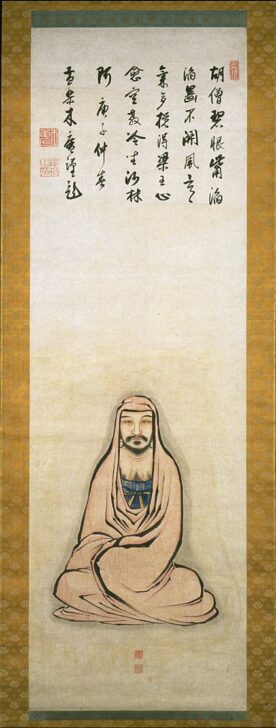Bodhidharma, from triptych of Three Zen Masters: Linji, Bodhidharma and Deshan
Yiran Xingrong (J. Itsunen)

Description
In this set of three hanging scrolls (1975/2.181, 182, 183), three great Zen patriarchs are portrayed in the lighthearted manner that was characteristic of paintings produced for the Ôbaku Zen sect. Bodhidharma, the Indian monk credited with introducing Zen to China in the fifth century, is given the place of honor in the center (1975/2.182). His limbs are completely concealed by his red robe, and his frontal pose is taken almost directly from a well-established type that depicts his famous nine-year-long meditation. Here, however, the asymmetry and the sense of movement in the brushwork itself create the impression that Bodhidharma has just pulled his robes tighter about him to ward off a chill; and he looks directly out at us, rather than seeming lost in his own thoughts. Seated to his left is Linji (d. 866) (UMMA 1975/2.183), a famous Tang dynasty master from whom many of the most powerful Zen monasteries in China and Japan claimed descent. At Bodhidharma’s right sits Linji’s contemporary, Deshan (781–867) (1975/2.181), who was renowned for using few words and for his readiness to strike his students with his staff. (“If you are wrong, 30 blows! … if you are right, 30 blows!”) Again the artist has tampered with the standard images: with their slumped shoulders and downcast gazes, both Linji and Deshan—fierce personalities by all accounts—are recast as mild-mannered senior monks. This casual treatment of revered figures is seen also in the work of the Chinese painter Chen Xian, a renowned portrait artist whose work was very influential in establishing the Ôbaku style in China. Although several other versions of this trio are extant, the Museum’s triptych is widely recognized as one of the finest works of Ôbaku art outside of Japan.
Arts of Zen, February 15-June 15, 2003
M.Graybill, Senior Curator of Asian Art; Yiran Xingrong (Itsunen)
Japan, 1601-1668
Triptych of Three Zen Masters: Linji, Bodhidharma and Deshan
Edo period (1615 - 1868)
1658
Hanging scroll, ink and light color on paper
Museum purchase, Acquisition Fund, 1975/2.181-183
Yiran Xingrong was born in Ming Dynasty China (1368-1644), but emigrated to Japan as a spice
trader, eventually entering the Zen temple Kōfuku-ji in Nagasaki. As a monk, he sought to forge
closer connections between Japanese Zen Buddhism and Chinese Chan Buddhism, and
eventually convinced other Chinese monks to establish the Ōbaku Zen sect of Buddhism in
Japan. This triptych shows three Zen patriarchs: Bodhidharma the monk who brought Zen
Buddhism to China, flanked by the monks Linji and Deshan shown on the right and left
respectively. The inscriptions were written by Muyan, one of the main founders of Ōbaku Zen.
Both the casual depictions of these patriarchs as well as the seemingly irreverent tone of the
inscriptions reflect the Zen Buddhist seemingly iconoclastic interest in complete detachment
from the physical world, including Buddhism’s own teachings. The inscriptions may be
translated as follows:
Bodhidharma:
“The barbarian monk with green eyes certainly talks a lot!
Hist teeth open to the wind, he is filled with a haughty spirit.
He agitated the Liang Emperor, while his own heart became more empty,
Unconcerned, he sat in the cool, near the twin trees by the riverbank.”
Linji:
“When he shouted in a voice like thunder,
He aroused the monks’ inner spirit
His wisdom has been polished for a thousand years but never lost;
He taught the three mysteries and did not ask for the Buddha.”
Deshan:
“A single dot in the great void, a single drop in a huge gully;
He burned up the sutra when enlightenment appeared.
He points to sages and commoners alike with his stick.
This this world of karma, he is true Buddha.”
(Translation by Stephen Addiss)
Usage Rights:
If you are interested in using an image for a publication, please visit https://umma.umich.edu/request-image/ for more information and to fill out the online Image Rights and Reproductions Request Form.